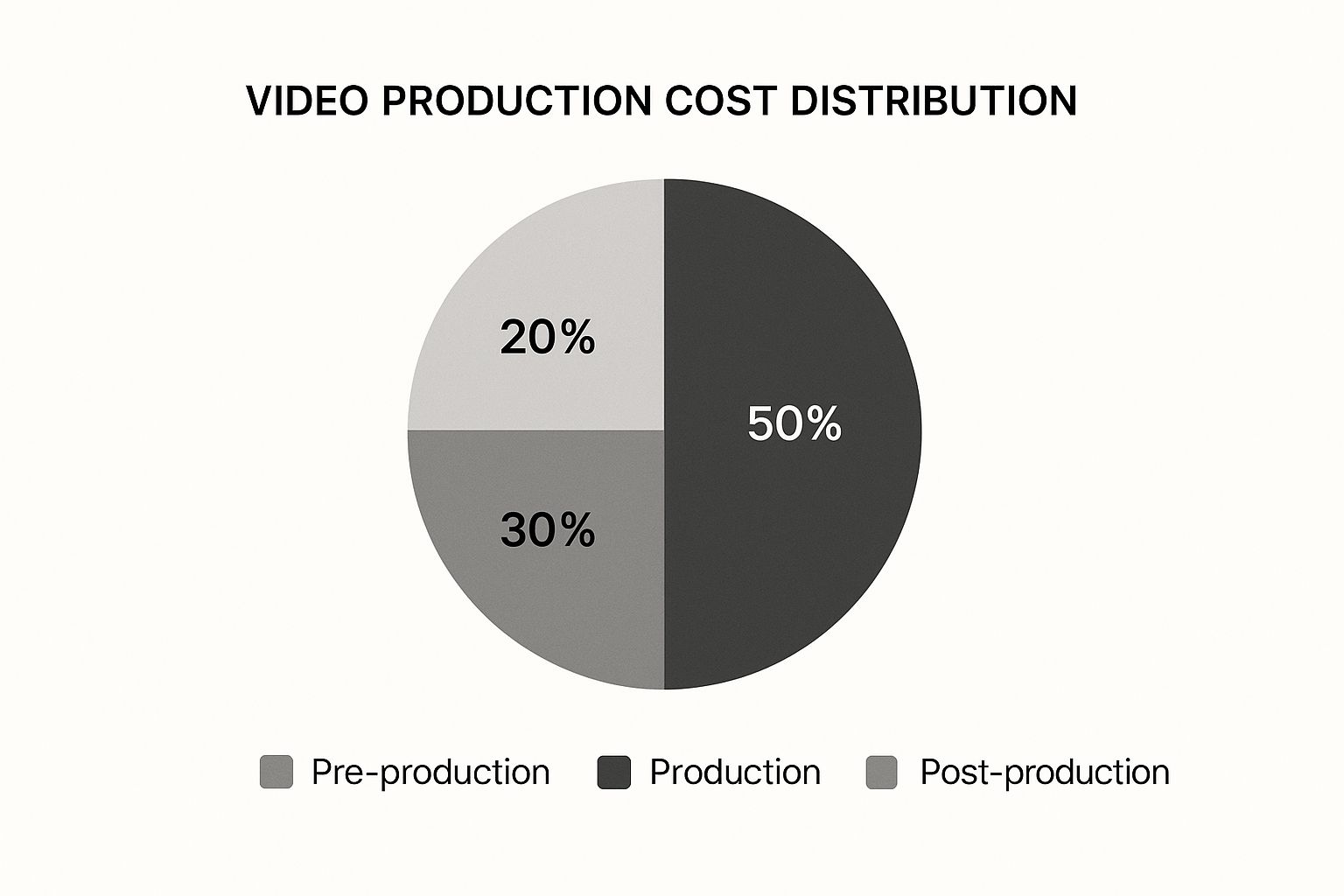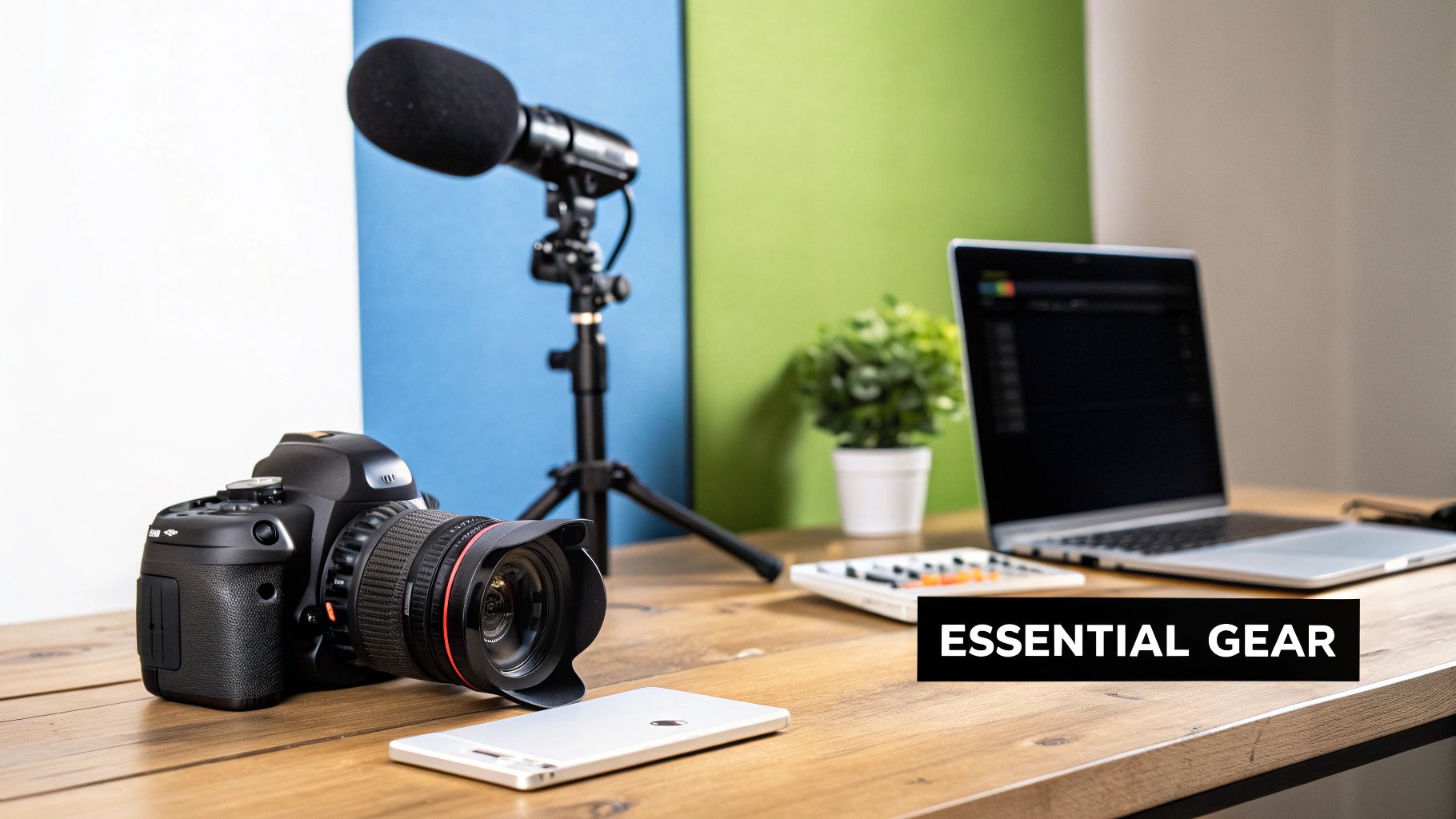Getting Started Without Breaking The Bank

Let's face it, running a small business means wearing a lot of hats. The thought of adding video production to your already overflowing plate might seem daunting. But believe me, creating effective videos doesn't require a massive budget. I've witnessed firsthand how small businesses thrive with simple, resourceful approaches. The secret? Knowing your audience and delivering genuine content.
Starting Simple With What You Have
Ditch the idea that you need expensive equipment right off the bat. Your smartphone and some basic lighting can work wonders. Think about it – aren't most people watching videos on their phones anyway? Starting with that format just makes sense.
Prioritize clear audio and good lighting. These two factors significantly impact how viewers perceive your videos. You can even create a DIY lighting setup with lamps and white sheets to dramatically improve your video quality.
Choosing the Right Video Types
Different video types achieve different goals. Short, engaging product demos are great for highlighting key features. Behind-the-scenes peeks into your business can build brand personality.
Customer testimonial videos offer incredibly convincing social proof, demonstrating the value of your product or service to potential customers. Experiment with different formats to see what clicks with your audience. You might even consider small business branding services to level up your brand image.
Building a Sustainable Workflow
Video production should fit into your current schedule, not take it over. Begin with small, manageable goals. Perhaps it's filming one short video per week or blocking out an afternoon for editing.
Create a simple production calendar and stick to it. Consistency is key for building momentum and getting results. Remember, it's a marathon, not a sprint.
The use of video by small businesses has exploded. As of 2025, a whopping 55% of small businesses use video marketing, and 89% of all businesses use video as a marketing tool. This shows just how important video has become across the board. Discover more insights on video marketing statistics. By starting small, prioritizing quality, and staying consistent, you can tap into the power of video without emptying your pockets or sacrificing precious time.
Planning Videos That Actually Connect With Your Customers
The biggest mistake I see small businesses make? Jumping into filming without a plan. They get so excited about making videos, they forget the most important thing: their audience. Believe me, amazing visuals don't matter if they aren't connecting with the right people. Successful video marketing isn't about expensive equipment; it's about really knowing your customer.
Understanding Your Audience's Needs
Think about the videos you enjoy. What keeps you watching? It's probably content that speaks to your interests, answers your questions, or solves a problem. It's the same for your customers. Before you even think about picking up a camera, understand what makes your target audience tick.
What are their frustrations? What are they worried about? What questions do they keep asking? Once you understand these core needs, brainstorm video ideas that speak directly to them. To get started with video production on a budget, check out this guide on eCommerce video production.
Mapping Videos to the Buying Journey
Different videos have different jobs. Some build awareness, others educate, and some convert viewers into paying customers. Consider the different stages of your customer's buying journey:
-
Awareness: Here, potential customers are just discovering your brand or realizing they have a problem you can solve. Create videos that introduce your business, highlight the problem, and position yourself as a helpful expert.
-
Consideration: Now, the customer is actively looking for solutions. This is your chance to show off your expertise with educational videos, product demos, and customer testimonials.
-
Decision: The customer is ready to buy, but might be comparing you to competitors. Videos focusing on benefits, pricing, and guarantees can help them choose your business.
Creating a Content Calendar That Converts
A good content calendar keeps your video production consistent and strategic. It helps you balance valuable information with subtle promotion, so your audience doesn't feel like they're constantly being sold to. Start by mapping out video topics and aligning them with the buying journey stages.
For example, a bakery might create videos on baking tips for beginners (awareness), then videos showcasing signature cakes (consideration), and finally, a video about online ordering (decision). Also, remember that video trends are constantly changing. One big shift is towards shorter videos. The average length dropped from 168 seconds in 2016 to 76 seconds in 2023, and it's expected to get even shorter. Find more video marketing stats here. This means adapting your content to shorter, more digestible formats. By planning strategically, you nurture leads, build trust, and drive conversions without being pushy.
To help you visualize this, here's a handy table:
Video Types And Optimal Lengths By Platform: Strategic guide to video formats and timing that maximize engagement across different platforms for small businesses
| Platform | Optimal Length | Best Video Type | Engagement Rate |
|---|---|---|---|
| Instagram Reels | 15-30 seconds | Short, engaging, attention-grabbing content | High |
| YouTube | 2-10 minutes (depending on topic) | Tutorials, reviews, in-depth explanations | Medium |
| TikTok | 15-60 seconds | Trendy, entertaining, quick tips | High |
| 1-3 minutes | Behind-the-scenes, stories, product demos | Medium | |
| Under 2 minutes | Industry insights, company news, thought leadership | Medium |
This table highlights the importance of tailoring your video length and type to each platform. Shorter, engaging content thrives on platforms like Instagram Reels and TikTok, while longer, more detailed videos perform better on YouTube. Focusing on the right format for each platform is key to maximizing engagement.
Filming Professional-Looking Videos With Basic Equipment

Producing quality video content for your small business might seem daunting, but trust me, it doesn't have to be. I've helped plenty of small business owners just like you create amazing videos without breaking the bank. The biggest misconception? You don't need a ton of expensive gear. A smart approach to the process, especially in the initial stages, can save you a lot of time and money. The graphic above illustrates how the costs typically break down. Notice how production eats up the biggest slice of the pie. This is exactly why efficient filming is so important.
I’ve found that getting the basics right makes all the difference. And one of the biggest game-changers? Lighting. Seriously, good lighting can transform your videos from amateur to awesome.
Mastering the Art of Lighting
Natural light is your best friend (and it's free!). Filming near a window, especially during the "golden hour" (sunrise and sunset) can give you that beautiful, soft light. But remember, natural light can be unpredictable. Cloudy days can throw off your whole setup.
If you want more consistency, a simple three-point lighting setup can work wonders. No need for expensive studio lights. I’ve used regular household lamps with some white fabric draped over them to diffuse the light and it works perfectly. The key light is your main light source, focused on your subject. The fill light softens any harsh shadows created by the key light. Finally, the backlight helps separate your subject from the background, adding a touch of professional polish.
Achieving Crystal-Clear Audio
Here's the thing: people will forgive a slightly less-than-perfect video, but bad audio? That's a no-go. A small investment in a lavalier microphone (those little clip-on mics you often see in interviews) can significantly improve your audio quality. They’re surprisingly affordable.
Find a quiet spot to film to minimize background noise. Even a subtle hum can be distracting. Pro tip: record a few seconds of "room tone" – the sound of the empty room. This helps editors clean up any background noise inconsistencies during post-production. If you’re looking for professional editing help, check out freelance video editing rates.
Smartphone Filming Secrets
Your smartphone camera is more powerful than you think. Today’s phones can shoot incredibly high-quality video. The trick is knowing a few simple techniques. The rule of thirds is a great starting point for composition. Imagine a 3×3 grid on your screen. Positioning your subject at the intersection of these lines creates a visually appealing shot.
Shaky footage is a major distraction, so stabilization is key. A small tripod or even a stack of books can work wonders. And don't be afraid to experiment with different angles! Filming from a slightly higher angle can be flattering and give you a more confident presence on camera.

This screenshot shows the wide range of equipment available at B&H Photo Video. While professional gear offers advanced capabilities, remember that mastering basic techniques with simpler equipment can yield fantastic results for your small business videos. Don’t get overwhelmed by all the choices.
To make sure your customer testimonials shine, consider using a video testimonial script generator. It can help you get structured and impactful testimonials. By focusing on these simple tips and techniques, you can create professional-looking videos without overspending and connect with your audience effectively.
To help you get started, here’s a handy table outlining equipment options for different budget levels:
Essential Video Equipment By Budget Level
Practical equipment recommendations with real costs for different investment levels, from beginner to professional setups
| Budget Range | Camera | Audio | Lighting | Total Cost |
|---|---|---|---|---|
| Beginner (<$200) | Smartphone | Lavalier Microphone (~$20) | DIY Diffused Lighting (~$10) | ~$30 |
| Intermediate (~$500) | Entry-Level DSLR (~$400) | External Recorder (~$80) | Softbox Lighting Kit (~$50) | ~$530 |
| Professional (~$2000+) | Professional Camcorder (~$1500) | Shotgun Microphone (~$300) | Professional Lighting Kit (~$500) | ~$2300 |
This table provides a general guide. Remember, creativity and technique are often more valuable than expensive gear, especially when starting. You can gradually upgrade your equipment as your needs and budget evolve.
Editing That Enhances Your Message Without The Learning Curve

This screenshot shows how user-friendly Canva's video editing interface really is. Even if you've never edited a video before, the layout makes trimming clips, adding text, and dropping in music incredibly easy. It's perfect for creating professional-looking videos without needing expensive or complicated software. This makes video production much more accessible for small businesses.
Choosing The Right Software (And Budget)
Okay, so you've filmed your video. Now what? Choosing the right editing software is key. If you’re just starting out, I recommend checking out user-friendly options like Canva and iMovie. They both have simple interfaces and drag-and-drop functionality. They’re ideal for creating short, engaging content without a huge learning curve.
There are also some powerful free tools out there. DaVinci Resolve is a great example. It offers professional-grade editing capabilities without the hefty price tag. In fact, DaVinci Resolve is what I used when I first started editing, and I was blown away by how powerful yet intuitive it was. As your needs grow, you might want to explore paid software like Adobe Premiere Pro, which unlocks advanced features. But honestly, mastering the basics first is a solid approach.
Essential Editing Techniques For Impact
Effective editing isn't about crazy effects. It’s about making your message shine. Think of it like polishing a gem. Removing “ums,” “ahs,” and awkward pauses makes a world of difference. From my experience, even a few seconds of dead air can make a video feel unprofessional. It can also cause viewers to lose interest. Tightening up your footage keeps the momentum going and your audience engaged.
Smooth transitions between clips are important too. They help create a seamless flow and prevent your video from feeling choppy. Simple cross dissolves or fades are often all you need. Don't overdo it with flashy transitions—they can actually be distracting.
Subtly adding your logo and brand colors reinforces your professional image. Consider a lower third graphic with your website address at key points. This reminds viewers who you are without being intrusive. Consistent branding across your videos builds recognition and makes you look more professional.
And don't forget about audio! Viewers will put up with less-than-perfect visuals, but bad audio is a dealbreaker. Make sure your dialogue is clear and at a consistent level. The background music shouldn't overpower your message either.
Efficiency Through Templates And Workflows
Once you’ve found an editing style that works for your brand, create templates. This will save you a ton of time down the road. For example, you could create a template for your YouTube intro and outro with your logo animation and brand music. This gets rid of repetitive tasks and ensures brand consistency across all your videos.
A structured workflow is also important. It streamlines your editing process. This might involve organizing your footage, labeling files clearly, and having a consistent editing sequence. A clear workflow keeps you organized and on track.
Accessibility And Optimization: The Finishing Touches
Captions are essential. They're not just for accessibility; they also boost engagement. Lots of people watch videos with the sound off, particularly on social media. Captions ensure your message gets across regardless. Plus, they’re good for SEO!
Thumbnails are your video’s first impression, so make them count! A clear image representing your video content, combined with engaging text, can significantly increase your click-through rates. Think of your thumbnail as a mini-movie poster—it needs to draw viewers in.
Finally, optimize your videos for different platforms. YouTube, Instagram, and Facebook all have different recommended video dimensions and file sizes. Optimizing for each platform ensures your videos look great and play smoothly, no matter where they’re viewed. This small step can seriously enhance the viewer experience. Following these tips will help you create videos that look professional and connect with your audience, driving results for your small business.
Smart Distribution Strategies That Multiply Your Reach

You've poured your heart and soul into creating amazing videos for your small business. That's fantastic! But hitting "upload" is just the starting line. The real race begins with distribution – getting your videos seen by the right eyes. Don't just leave it to chance. Smart distribution is where the magic truly happens.
Identifying Your Audience's Online Hangouts
First things first: know your audience. Where do they hang out online? Are they Instagram addicts, LinkedIn lurkers, or YouTube tutorial junkies? This is crucial. Imagine spending hours optimizing for YouTube when your ideal customer lives on Instagram. Not ideal, right? Match your distribution efforts to where your audience actually is. You might be interested in: small business marketing strategies.
Adapting Your Content For Each Platform
Each platform has its own vibe. What kills on TikTok might flop on LinkedIn. Repurposing is your best friend here. Got a long, in-depth video for YouTube? Awesome. Now chop it into bite-sized nuggets for Instagram Reels or TikTok. You're maximizing your efforts and speaking the right language on each platform. I once made a five-minute YouTube video about a new product. Then, I turned it into several 15-second teasers for Instagram Stories, linking back to the full video. The result? Way more views and engagement.
Crafting Compelling Video Descriptions and Hashtags
Descriptions and hashtags? They’re your secret weapons. Don't just throw on a generic title. Write descriptions that grab attention and tell people exactly what they'll get. Use relevant keywords – they help search engines find you. Hashtags are just as vital; they categorize your content. But don’t go crazy. A few well-chosen hashtags are far more effective than a massive, irrelevant list.
Timing Your Posts For Maximum Visibility
When you post is just as important as what you post. Consider your audience's online habits. When are they most active? Test different posting times and see what works best. You'll quickly find the sweet spot for maximum engagement.
Building Genuine Engagement Through Community Interaction
Building a community around your videos is pure gold. Respond to comments, answer questions, and join conversations. It shows you care. When people feel valued, they become loyal fans and enthusiastically share your content. I've seen this turn casual viewers into paying customers.
Leveraging Email Marketing, Website Optimization, and Partnerships
Don't stop at social media. Email marketing is still a powerhouse. Include video links in your newsletters. Optimize your website for video too. Embed videos directly on your product pages or blog. This keeps visitors engaged and boosts your SEO.
Partnerships are another fantastic avenue. Team up with other businesses or influencers in your industry. Cross-promote each other's videos. It’s a win-win, exposing both of you to new audiences. Using these distribution strategies, you'll turn your videos into powerful marketing tools that deliver real results for your business.
Measuring Success And Maximizing Your Video Investment
You’ve poured your heart and soul (and maybe some budget!) into creating amazing videos. But how do you know if they’re actually making a difference for your small business? It’s tempting to get caught up in views and likes, but I’m here to tell you, there’s a better way.
Beyond Vanity: Metrics That Matter
Forget the surface-level stuff. Let's talk about the metrics that truly indicate growth. Engagement is key. Are people commenting, sharing, or saving your videos? That’s a sign they’re genuinely interested. Think of it like a conversation, not just a broadcast.
Another important metric is click-through rate. If you're adding links in your videos or descriptions, are people clicking? This shows how effective your calls to action are. Are you guiding viewers towards the next step?
Finally, the gold standard: conversions. Are your videos resulting in sales, sign-ups, or inquiries? This is the ultimate test. Track how many viewers take that desired action. These are the numbers that boost your bottom line. Want to keep people hooked? Check out some tips on increasing YouTube watch time.
Setting Up Tracking Systems and Interpreting Data
Knowing what to measure is half the battle. The other half is knowing how. Luckily, most video platforms have built-in analytics. Get to know these tools! They're a treasure trove of information.
Don't feel overwhelmed by the data. Focus on the metrics that align with your specific goals. Want more brand awareness? Track reach and engagement. Looking for sales? Track conversions. Need a hand with your overall branding? Our guide on branding services for small businesses might be helpful.
Using Insights To Improve Future Content
Data without action is like a car without gas. It won’t get you anywhere. The real magic is using those insights to make your next video even better.
Notice a drop-off in viewers at a certain point? Maybe that section needs a refresh. Is it too slow? Confusing? Use that feedback to refine your approach.
Find your best-performing videos and figure out what made them work. Was it the topic? The style? Replicate those winning elements in future projects. This “look back to move forward” strategy is incredibly powerful. Speaking of moving forward, video marketing budgets are growing. In 2025, only 5% of companies plan to decrease their video spend, while more than half plan to increase it. That shows the value businesses place on video. In fact, 93% of marketers report a good ROI from video marketing. Pretty compelling, right? Discover more insights.
Scaling Your Video Production Process
As your business grows, so will your video needs. You might start doing everything yourself, but as demand increases, think about outsourcing tasks like editing or animation. This frees you up to focus on the bigger picture.
When outsourcing, choose your partners wisely. Find professionals who get your brand and share your vision. Clear communication is essential for a smooth process. Keep those quality standards high as you increase your content volume. That's the key to long-term success.
Your Video Production Action Plan
So, you’re ready to make some video magic happen for your business? Great! This action plan breaks down video production into bite-sized weekly milestones, making the whole process feel much less daunting.
Week 1: Pre-Production Power-Up
This week, it's all about planning. Think of it like building a house – you wouldn't start without blueprints, right? First, nail down your core message. What's the single most important thing you want viewers to remember? Maybe it's a key feature of your product, a core brand value, or a limited-time offer. A creative brief template can be super helpful for organizing your thoughts.
Next, sketch out your video content. This isn't about writing a perfect script, just a rough outline of the key points and visuals you want to include. Personally, I love using bullet points for this – keeps things nice and organized.
Finally, gather your resources. Think equipment, props, locations, music, graphics… anything you'll need for the shoot. Getting this sorted now will save you a ton of time and stress later.
Week 2: Filming Like a Pro (Without The Price Tag)
Lights, camera, action! This week is all about capturing great footage. Remember those lighting tips we discussed? Set everything up beforehand to avoid delays and keep your focus where it should be: on filming.
Before you hit record, do a quick audio check. A few seconds of silence will help you pick up any unwanted background noise. Trust me, good audio is essential.
Once you’re ready, focus on delivering your message clearly and confidently. Don't be afraid to do multiple takes. I often find the best takes happen after a few warm-up runs.
Week 3: Editing Magic
This is where your video really starts to shine. Import your footage into your editing software (I recommend creating a separate project folder for each video to keep things tidy).
Now, start trimming unnecessary footage, tightening up pauses, and adding smooth transitions. Remember, less is often more. I once worked on a video where the client initially wanted tons of flashy effects. We ended up stripping it back, and the simpler version was way more effective.
Add background music and graphics to enhance your message, but keep it subtle. The music should complement your brand, not overpower it. Captions are another great addition – they improve accessibility and boost engagement.
Week 4: Distribution Domination
It's time to get your video out there! Choose the right platforms for your audience. Are they hanging out on YouTube, Instagram, Facebook, or LinkedIn?
Write compelling descriptions and titles that grab attention and include relevant keywords. Think of these as mini-ads for your video.
Schedule your posts for optimal viewing times. When are your customers most active online? Scheduling tools can automate this process and save you a lot of hassle. Once your video is live, don't forget to engage with your audience! Respond to comments and join the conversation.
Troubleshooting and Continuous Improvement
Sometimes, things go wrong. Equipment fails, creative blocks happen… it’s part of the process. The important thing is to be prepared. Have backup plans, and don't hesitate to reach out for help if you need it.
And finally, track your results! Use the data to refine your approach. Which videos performed well? What could be improved? Video production is an ongoing journey of learning and improvement.
Ready to take your brand to the next level with professional creative services? Visit Creativize to connect with top talent in your area.

